
Whale Watching Colombo, Sri Lanka
Whale watching in Colombo, Sri Lanka, goes back to the 1980s, with the first whale sighting in East Sri Lanka by a group of marine biologists. They observed that sperm and blue whales were coming to the harbor in Trincomalee (read more about Trincomalee) with the help of a submarine canyon. Sri Lanka is a whale-watching hot spot in the region and allows visitors to see two dozen whale species.
Table of Contents
- Whale Watching Colombo, Sri Lanka
- The scope of dolphin and whale monitoring
- Target species, locations, and prime seasons:
- Can we have a 100% guaranteed whale watching tour in Colombo?
- The best whale-watching tours from Colombo
- 1 Day Sri Lanka whale watching tour Colombo in a nutshell
- 2 Days Whale watching tour Colombo in a nutshell
- Have fun with blue whale watching in Colombo
- Whale watching in Colombo the historical facts
- Where to go for Blue whale watching in Sri Lanka?
- Types of whales in Sri Lanka
- Resident whales of Sri Lanka
- Sperm whale super pods
- Blue whale migration in Sri Lanka
- Whale migration path
- Scientific findings on Sri Lankan whales
- Whale watching Colombo allows you to spot a blue whale unique to Sri Lanka
- Threats to the blue whales
- Regulating the whale-watching Colombo is a need of the hour
- Blue whale accidents
- Whale watching Colombo, where and when?
- Blue whale watching Sri Lanka, Mirissa
- Blue whale watching Sri Lanka how much does it cost
- Watching whales in Kalpitiya
- Sperm whale watching in Sri Lanka
- Spotting a large gathering of sperm whales
- The nature of whale watching Colombo
- Ready to take a whale-watching Colombo with Seerendipity tours?
Whale Watching Colombo, Sri Lanka
Whale watching in Colombo, Sri Lanka goes back to the 1980s, with the first whale sighting in East Sri Lanka by a group of marine biologists. They observed that sperm and blue whales were coming to the harbour in Trincomalee (read more about Trincomalee) with the help of a submarine canyon. Sri Lanka is a whale-watching hot spot in the region and allows visitors to see two dozens of whale species. The blue whale is the biggest creature in the world and is found in a great number in the sea of Sri Lanka. Due to the fact that Sri Lanka is surrounded by a large number of whales, the south Indian nation has become a whale-watching hot spot in the Indian Ocean and attracts a large number of travellers from all around the world. Especially during the last few decades, Sri Lanka has become a premier locality for seeing and studying blues.
The sea off Sri Lanka is shallow and outward from Sri Lankan shores is the continental shelf: then the seafloor gently slopes to an edge where the bottom drops steeply into the deep. This big creature enjoys cruising waters at the deepening shelf edges. The abundance of food at the edges is the main reason for them to love shelf edges, and they may also use the shelf edges in navigating.
The southernmost wedge of the Indian (sub)continental shelf happens to ‘pinch in’ close to the Sri Lankan shore, precisely where blues migrating back and forth between the Arabian Sea and the Bay of Bengal find their shortest route. Some of them sing along the way.
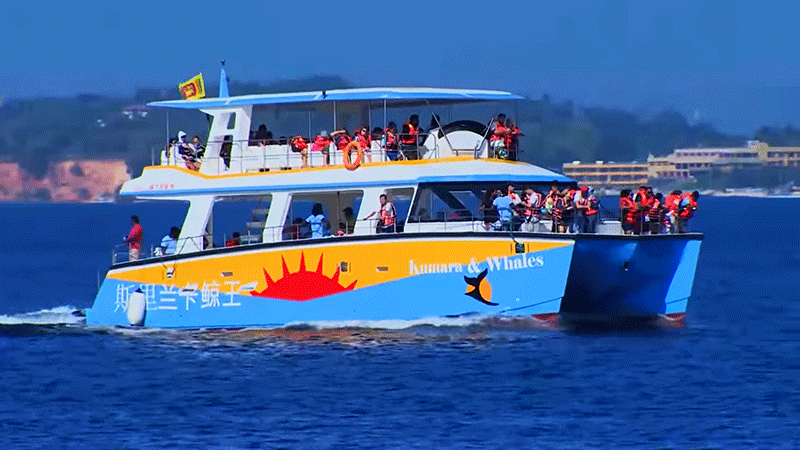
Mirissa is a popular 2-day trip place in Sri Lanka, which offers many possibilities for Sri Lanka beach holidays as well as Whale watching boat tours. Whale watching trip is part of most Sri Lanka trip packages such as 5 day Sri Lanka southern tour.
The scope of dolphin and whale monitoring
Sri Lanka has experienced a notable surge in tourism since the resolution of protracted periods of unrest in 2009. The whale-watching industry is one of the most rapidly expanding sectors of the tourism industry. Sri Lanka is gaining international recognition for its blue whale observation opportunities in at least two distinct locations between December and July. Although other dolphin and whale species may be encountered for opportunistic reasons during excursions, blue whales are unquestionably the most commonly visited.
Target species, locations, and prime seasons:
Sri Lanka’s three primary whale and dolphin observation areas are located on the northwest coast, in Kalpitiya, in the south-west, and in Trincomalee, in the north-east. Blue whales are the most commonly observed species during whale-watching excursions in Sri Lanka. They are typically visible off the coast of Mrissa from December to March and off the coast of Trincomalee from March to July. Bryde’s whales and sperm whales are occasionally spotted fortuitously during blue whale-focused excursions. Platforms for whale viewing range in size from small double-decked vessels that can accommodate up to 300 passengers to small boats that can accommodate 4-6 passengers. Even the Sri Lankan Navy provides tours for whale viewing. Tours occasionally venture as far offshore as 20 kilometers; therefore, vessels must be sufficiently large and powerful to endure potentially rough seas and longer journeys.
Can we have a 100% guaranteed whale watching tour in Colombo?
A large number of tour operators offer blue sighting trips off Mirissa (southern coast) and the East coast. However, most of them do not guarantee a blue whale sighting. Seerendipity tours guarantee the blue whale sighting on every trip they make and you can repeat the tour without paying anything if you were not able to see the whales on your blue whale watching trip.
- 100% Safe on a Super grade luxury passenger cruiser.
- Licensed by the government of Sri Lanka
- You will get one of the most comfortable whale-watching cruisers in Mirissa
- Everyone is getting on the upper deck for a wider and deeper view.
- Specially designed for whale-watching adventure trips WITH SPACE around for observation. 100% satisfaction guaranteed.
- Morning Tea/Coffee| Breakfast | Bottled water | Fruits & Snacks- all these free onboard
- We follow International whale watching guidelines & best practices issued by the whales & dolphin conservation in the UK
- Two licensed captains | six lifeguards with international licenses | one naturalist on board for live commentary
- The sighting rate is 99.9%.
- If you don’t see whales, you can have the tour the next day free
- Your pick-up time is to be informed by phone or on Whatsapp or by email soon after your booking is made. More info on this whale-watching tour.
The best whale-watching tours from Colombo
- 1-Day Whale watching tour Colombo
- 2 Days whale watching tour Colombo with the southern coast
1 Day Sri Lanka whale watching tour Colombo in a nutshell
- 04.00 AM Start the journey from Colombo
- 06.00 AM Reach Mirissa harbour
- 06.30 AM set off on the whale-watching tour
- 10.30 AM starts the return journey
- 02.00 PM Reach the hotel in Colombo
More information on 1-day whale watching from Colombo

2 Days Whale watching tour Colombo in a nutshell
Seerendipity tours mainly offer 2 types of whale watching tours from Colombo, and they can be booked from 140+ beach hotels on the west coast. One day tour from Colombo mainly includes the whale watching trip. The 2 days tour from Colombo includes a whale-watching boat trip as well as visits to many tourist attractions in southern Sri Lanka such as Galle Fort, mask museum, Hikkaduwa beach, Madu river estuary, and sea turtle conservation project.
Day 1 of 2 days Colombo whale watching tour
- 08.00 AM leave for mirissa via Kalutara and Bentota
- 10.00 AM visit the sea turtle conservation project
- 11.00 AM explore Madu River estuary in a boat tour
- 01.00 PM visiting mask museum
- 02.00 PM Lunch break
- 03.00 PM visit moonstone mines
- 04.00 PM walking tour of Galle Fort
- 06.00 PM check-in to the hotel in Mirissa and leisure
Day 2 of 2 days Colombo whale watching tour
- 06.30 AM Start the whale-watching boat tour
- 12.00 PM leave for Colombo after whale watching boat trip
- 02.00 PM reach the hotel in Colombo
More information on 2 days whale watching trip
Have fun with blue whale watching in Colombo
Whale watching Sri Lanka has become a popular activity among foreign travellers. Because Sri Lanka is one of the best places to observe whales and dolphins in the world. Being an island in the south of India, Sri Lanka is surrounded by the Indian Ocean. There is a high concentration of whales and dolphins in many parts of the Sri Lankan water, mainly in the sea of southwest Sri Lanka and the east coast of Sri Lanka.
Being a country in the International Whaling Association protected zone, is one reason for the large concentration of whales around the country. Same time Sri Lanka is located on the migration path of Whales in the Indian Ocean and it is also being a significant reason for a large number of whale sightings around the country.
To see a blue whale at sea is something most of us can only dream about.
To see more than once in a lifetime is a rarity reserved for a fortunate few.
To be in a boat surrounded by five or six blue whales is an experience so
profoundly moving, it inspires us to…fight for the conservation of whales and their ocean environment.
Genevieve Johnson
Conservationist
Whale watching in Colombo the historical facts
Whale watching in Sri Lanka goes back to the 1980s, with the first whale sighting on the East coast of Sri Lanka by a group of marine biologists. They observed that sperm and blue whales were coming to the harbour in Trincomalee (read more about Trincomalee) with the help of a submarine canyon.
Whales in east Sri Lanka were used in an award-winning film called Whales weep not, the very first underwater film, which was filmed in the natural habitat of Sperm whales. Even though Trincomalee was recognized as a whale-watching hotspot, it was not served as a safe place for such activities owing to the civil war that ended in 2009.
It was off the coast of Sri Lanka in 2003 that Genvieve Johnson the well-known cytological conservationist and broadcaster had her “profoundly moving experience. Sri Lanka is one of the few places in the world that can offer a wealth of such experiences, yet the country’s reputation as a marine mammal haven is of relatively recent date.
For centuries, Sri Lanka’s whales, dolphins and dugongs were secret known only to fisherfolk and other residents of the island’s coastal belt, as well as a small number of foreign mariners, whalers and naturalists.
The country first got the attention of international cytological attention
in the early 1980s, after three cetacean researchers-Hal Whitehead,
Jonathan Gordon and Roger Payee- documented the unusual frequency of great whale sightings off the Sri Lankan coast. Word began to spread beyond the cytological community in 1983, following an international conference held in Colombo to increase awareness of the country’s cetacean heritage and the importance of conserving it. (see “The Tulip Expedition” p.13).
Soon, whale-watching tours were being offered to a growing number of enthusiastic tourists and researchers.
Where to go for Blue whale watching in Sri Lanka?
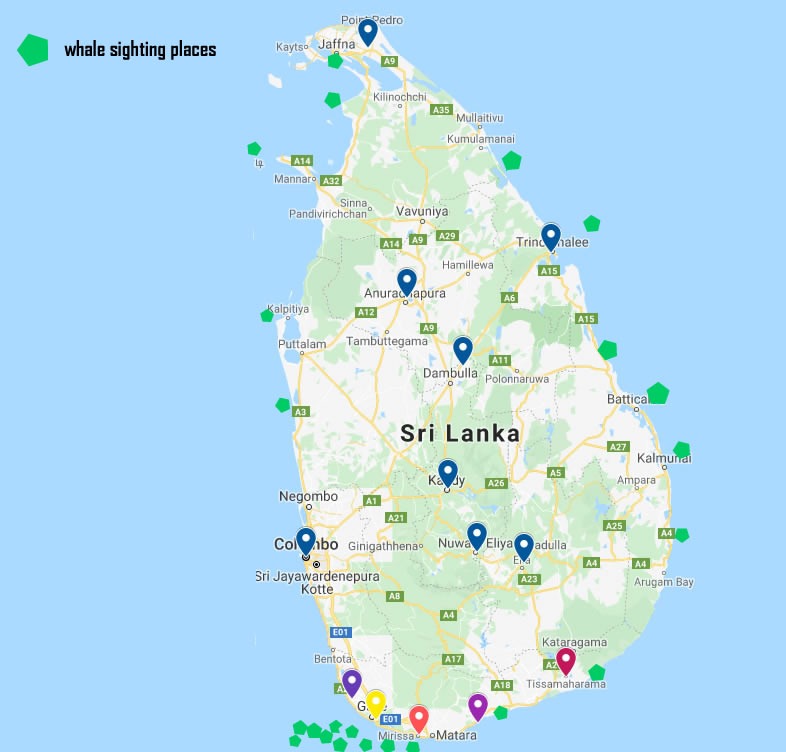
Whales are reported in all parts of the Sri Lankan waters other than North Sri Lanka. Owing to its shallowness this part of the sea makes it unsuitable for whales. Eastern Sri Lanka is also offering plenty of chances to observe Whales and dolphins.
Since the end of the Civil war (2009) in North-East of Sri Lanka, the sea off Trincomalee has also become a major whale watching destination and many travellers start their whale watching trip from the east coast. The sea off the southern coast is also equally popular for whale sightings and the sea off the south coast is also frequented by several species of whales.
Whale-watching had been a very popular activity among tourists in the country and commercial whale-watching was started more than a decade ago. The increasing number of tourists in the recent past has resulted in a high demand for whale-watching activities in the country.
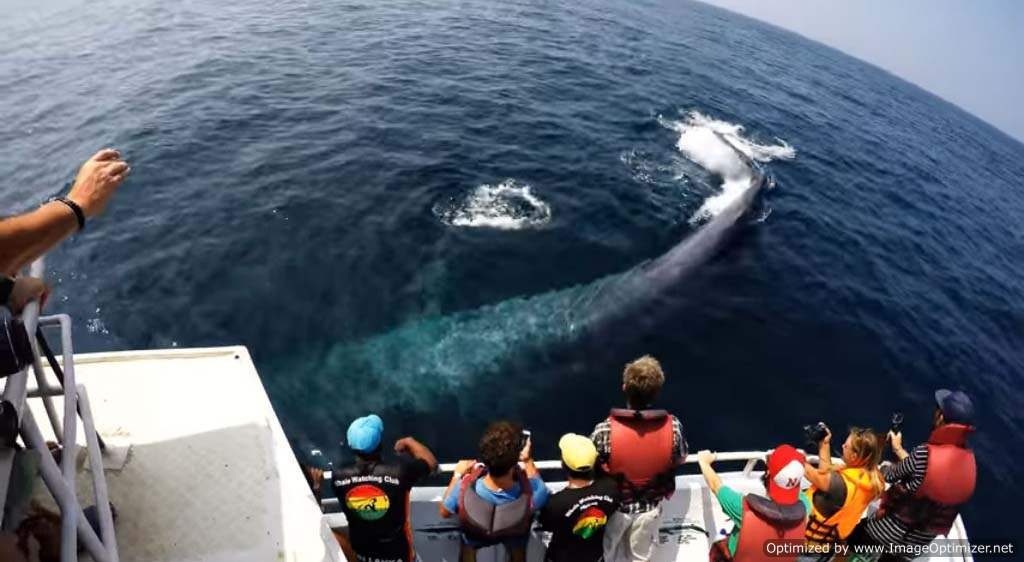
Types of whales in Sri Lanka
Rorqual whale family-Balaenopteridae
- Blue whale Balaenoptera musculus Migrant/Seasonal
- Fin Whale Balaenoptera physalus Migrant/Seasonal
- Sei Whale Balaenoptera borealis Possible/probable
- Bryde’s whale Balaenoptera edeni Resident
- Minke whale Balaenoptera acurorostrata Migrant/Seasonal
- Humpback whale Balaenoptera novaeangliae Known to be Present
Sperm whale family –Physeteridae & Kogiidae
- Sperm whale Physeteridae macrocephalus Nomadic
- pygmy sperm whale Kogia breviceps Resident
- Dwarf sperm whale Kogia sima Resident
Beaked whale family-Ziphiidae
- Longman’s beaked whale Indopacetus Pacificus Known to be Present
- Cuvier’s beaked whale Ziphius cavirostris Known to be Present
- Deraniyagala’s ginkgo-toothed beaked whale Mesoplodon ginkgodens Possible/probable
- Blainville’s beaked whale Mesoplodon densirostris Known to be Present
Blackfish family –Delphinidae
- Orca Orcinus orca Nomadic
- Sjhort-finned pilot whale Globicephaphala macrorhynchus Nomadic
- False killer whale Pseudorca crassidens Nomadic
- Melon headed whale Peponocephale electra Resident
- Pygmy killer whale Fersa attenuata Resident
There are five types of whales recorded around the country: blue whale, sperm whale, minke, melon-headed, and dwarf sperm. All types of whales and dolphins live in the deep waters around Kalpitiya in southeast Sri Lanka.
The biggest animal in the world Blue whale and sperm whale is reported very often around Kalpitiya. One does not need to travel far off to the sea like in most other whale-watching destinations, in order to observe whales in South-East Sri Lanka. November to December and March to April is considered the peak season for whale sighting in this region.
Resident whales of Sri Lanka
Lankan waters harbour four especially charismatic whales and dolphins: sperm whale, blue whale, orca and bottlenose dolphin.
In Southern Sri Lanka off Mirissa or Dondra head also reported a large number of sperm and blue whales. Anderson a well-known marine biologist believes that part of the whales that can be seen in southern Sri Lanka is resident whales.

Sperm whale super pods
There are 4 major species of whales and dolphins that can be spotted in Sri Lanka waters: sperm whales, blue whales, orca and bottlenose dolphins. Sri Lanka is one of the best places for spotting sperm whales in the world. Sperm whales come close to the shore and allowing the people to watch them easily from their boats. Sometimes are occurring in super pods, and these may consist of many dozens of whales at a time. Super pods have been seen in many parts of Sri Lankan water regularly over the last few years, especially in the northwest of Sri Lanka and the eastern part of the island. The waters around Sri Lanka are the only place in the world to spot such super pods regularly in the world.
Blue whale migration in Sri Lanka
A part of the whale population in Sri Lankan water considered migratory whales crossed over to the Indian Ocean from the Arabian Sea through the Bay of Bengal. Anderson believes that whales are passing the island on the way to the direction of the Bay of Bengal in January and April they are heading in the opposite direction passing Sri Lanka and Maldives alone on the way to the Arabian Sea.
The second research on marine life off the southern coast was conducted in 2003 and was called The Voyage of Odyssey the research had come up with many whale sightings in the region. According to marine biologists, southern deep water off Dondra point is the best site for whale watching on the island since it is located close to the shore.
Whale migration path
Being a country in the International Whaling Association protected zone is one reason for the large concentration of whales around the country. Same time Sri Lanka is located on the migration path of Whales in the Indian Ocean and it is also being a significant reason for a large number of whale sightings around the country.
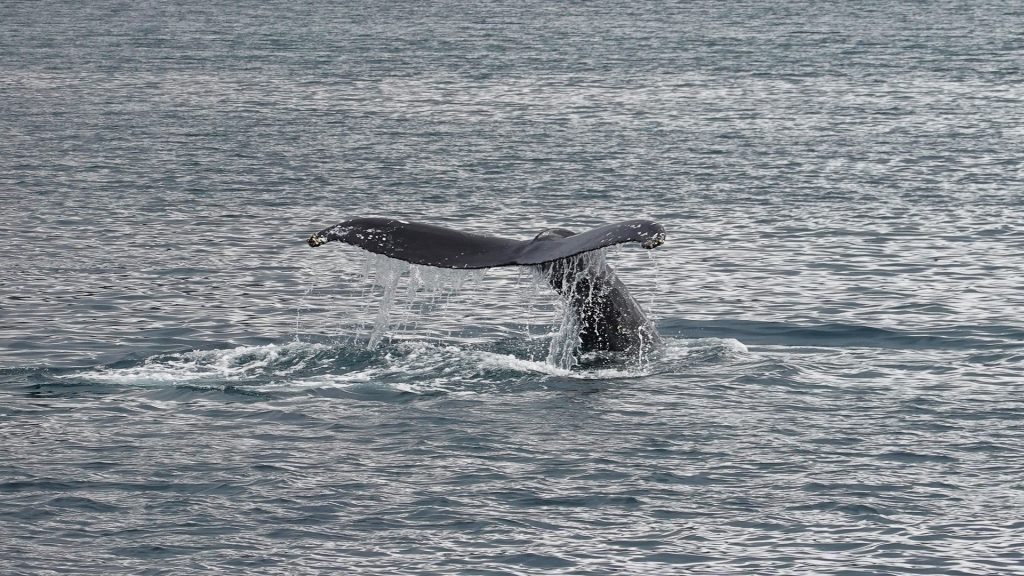
Scientific findings on Sri Lankan whales
Marine biologist Asha de Vos has conducted the first-ever major scientific study on blue whales in Sri Lanka. The study covered important facts about the whales of Sri Lanka, which are unique to the island. The study also shows how to implement an effective scientific conservation effort to protect this endangered marine animal. The behaviour of blue whales and the nature of threats to the existence of blue whales are important facts revealed in the press conference.
Whale watching Colombo allows you to spot a blue whale unique to Sri Lanka
According to the research findings, the blue whales of Sri Lanka are unique to the country. There are a lot of blue whales known to live in Sri Lanka. Southern Sri Lanka and the eastern part of the country are particularly popular for whale-watching in Sri Lanka. Even though the blue whale is globally declared an endangered animal species and is a protected animal, some countries are still engaged in whale hunting. Blue whales are being killed for their oil, meat, and other parts.
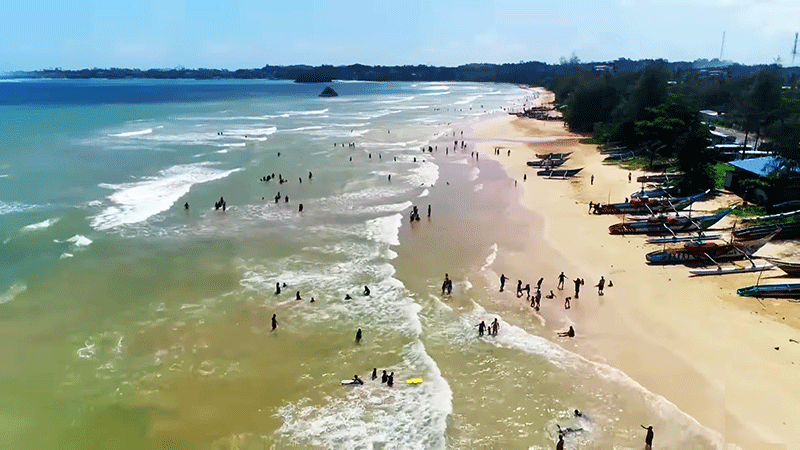
Today the total number of blue whales in the world is estimated to be around 10,000 and it is a sharp reduction from its population of 300,000 in the past.
Asha de Vos referred to the whales of Sri Lanka as the “unorthodox whales” because these animals behave differently than the other populations in the world. The longest blue whale discovered in Sri Lankan water is 25 meters; hence the blue whales of the Pacific Ocean are five meters longer.
Threats to the blue whales
The main threat to the existence of blue whales in Sri Lankan water is identified as the ships that pass southern Sri Lanka on the international sea route. A large number of blue whales had been killed so far owing to the ship strikes. One of the busiest sea routes in the world happens to be running across the area where blue whales reside and which is the main reason for the injuries of whales. The most recent such incident was heard on March 20, 2012, when a blue whale entangled onto the bow of a ship and was brought to the harbour.
Regulating the whale-watching Colombo is a need of the hour
According to the research unregulated whale watching is identified as a potential threat to the well-being of Blue whales. Today there are no rules and regulations involved with whale watching in Sri Lanka. The researchers opine that the whale-watching industry should be adhering to international standards and regulations to sustain whale watching as a long-term attraction on the island.
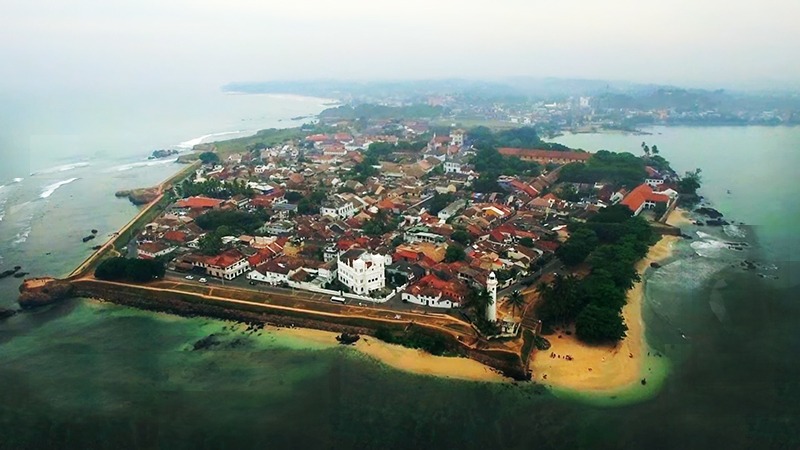
Blue whale accidents
A giant whale has washed ashore in west Sri Lanka, in the region of Kosgoda. Kosgoda is a fishing village and one of the most popular beaches in Sri Lanka located 70 km south of Colombo, which is a fishing village. The whale is still alive at the time the report is written, but it is suffering from a few wounds. The whale is about 100 meters in length. The whale is washed ashore by the current since it is wounded and not able to swim against the strong current. The wounded whale was carried to the shore by the strong current and the animal was stranded on the shore for two days.
Whale watching Colombo, where and when?
Whale watching in Sri Lanka can be done in several places on the island, depending on the weather conditions. The best place for whale watching in Sri Lanka off the south and west coast is from November to May, while the east coast is suitable for whale watching from May to October.
Blue whale watching Sri Lanka, Mirissa
Mirissa off the southern coast considered to be the best place for a top-notch whale watching experience in Sri Lanka. Mirissa is the place to spot a large concentration of blue whales and sperm whales. A typical whale watching trip off the coast of Mirissa lasts between 1 to 4 hours depending on the time spent for a whale sighting.
Whales are occurring about 1 km off the coast of Mirissa and dolphins are also can be spotted here. Whales can be seen here throughout the year but November to April is the main whale watching season here due to the favourable weather to travel on the sea.
Mirissa is located near the southern tip (Dondra) of Sri Lanka. Mirissa is a popular one-day trip place in Sri Lanka and can reach within 2 hours from Colombo. One can easily reach Mirissa from Colombo and the travel time is around 2 hours from Colombo to Mirissa by the southern expressway. The travel time between Mirissa and Colombo will be about 4 hours when you are using the A2 main road. Traveling from Colombo to Mirissa can be done by public buses, trains, or taxis.
Travelling by train between Colombo and Mirissa is comfortable, cheap and time-saving. Even though travel by Taxi is expensive compared to buses it is the best option to travel from Colombo to Matara and vice versa. It is very comfortable, safe and most importantly saves a lot of time.
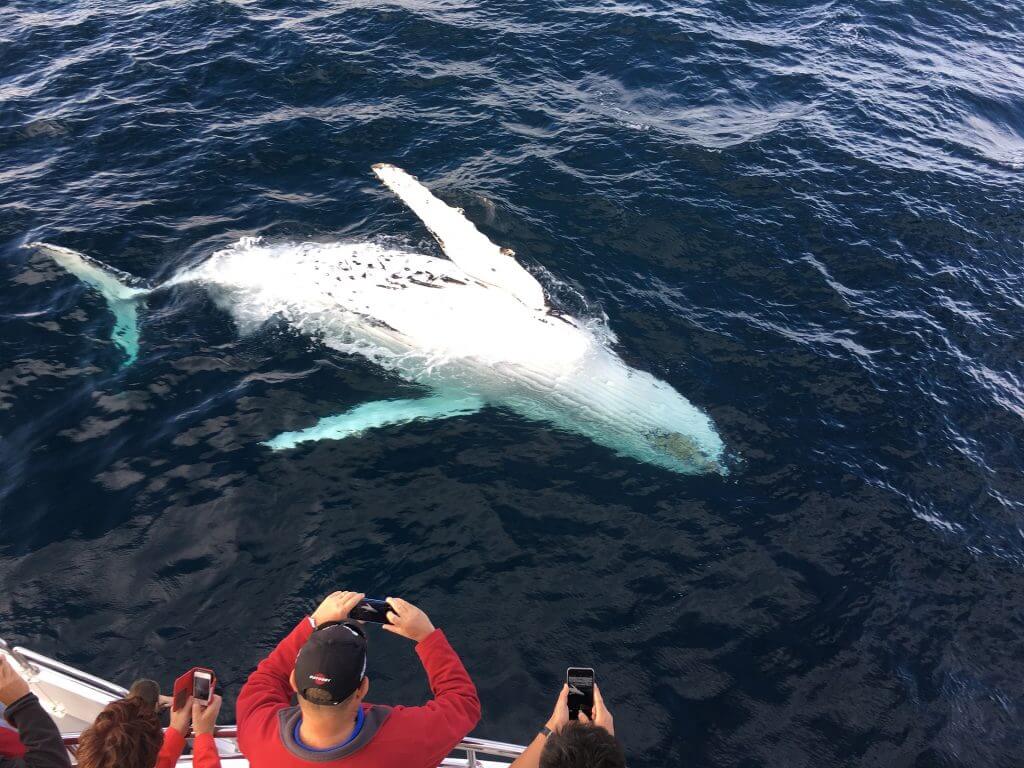
Blue whale watching Sri Lanka how much does it cost
Usually, the whale watching tour of Colombo is offered 7 days a week throughout the year, however, there can be the exception, in which the tours are abandoned without any prior notice. It is quite understandable because seafaring can be dangerous in certain situations due to the extreme conditions on the sea.
The cost of the whale-watching Colombo tour differs depending on the pick-location and drop-off location of the passengers. The traveller, who directly arrives at Mirissa harbour must pay US$ 98 per person for the whale watching tour, upon receiving the ticket, which includes all services and taxes.
Whale watching tours are organized by tour operators in Sri Lanka and offered as a standalone tour (whale watching tour) or as part of a Sri Lanka road trip.
Watching whales in Kalpitiya
Usually, Sri Lanka is popular around the world for spotting blue whales. “Blues whales Sri Lanka”, and “Colombo whale watching” are very popular keyphrases used by world travellers. We also get an email from travellers and most of them look for places to spot Blue whales.
Kalpitiya is not only good for watching dolphins but also for watching whales. The sea off Kalpitiya is one of the best places on the island to see whales, similar to Mirissa of southern Sri Lanka.
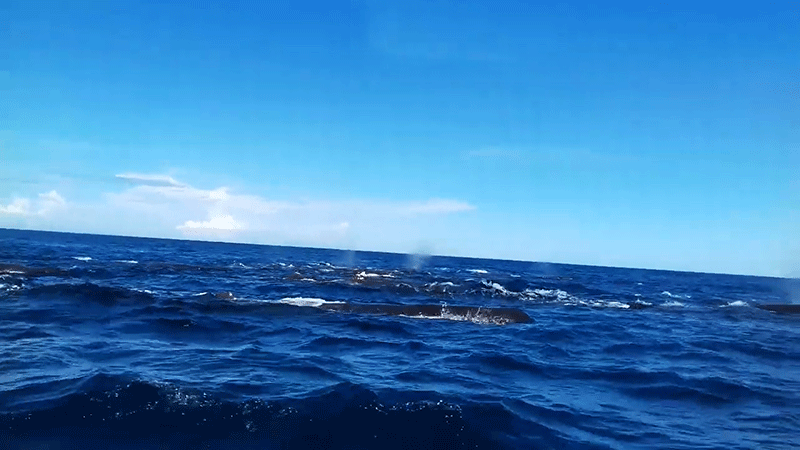
Sperm whale watching in Sri Lanka
I believe that most travellers do not know that this biodiversity hotspot also attracts large p[ods of sperm whales. Kalpitiya rank among the best places in Sri Lanka to spot these superpods. A large number of researchers gather in Kalpitiya in the months of March and April in order to carry out various research pertaining to sperm whales.
Spotting a large gathering of sperm whales
Researchers have been able to spot large gatherings of sperm whales off the coast of Kalpitiya since 2010. These sperm whale herds are consisting of hundreds of sperm whales (superpods), particularly in late March and April.
Earlier animal researchers predicted that superpods of sperm whales are sporadic. But now it is found that this gathering of sperm whales is a regular event and takes place every year in the months of March and April. Suoerpods season usually starts mid-march and superpods occur in the water until the 3rd week of April.
These sperm whale pods can be very big, scientist have spotted as many as 350 sperm whales in a superpod in 2015
The nature of whale watching Colombo
Blue whale watching in Sri Lanka is available in three flavours,
- Group blue whale watching Sri Lanka– this is the most popular form of blue whale watching in Sri Lanka and is available throughout the year except for a few days during the monsoon. Mirissa is most popular for blue whale watching in Sri Lanka. The blue whale-watching cruises set off in the early hours every day. Many dozens of specially built whale-watching cruises take around 75 guests to the sea and the trip may last between 2 hours to 5 hours.
- Private blue whale watching Sri Lanka-Private blue whale watching trip available for interested parties at a higher rate than the earlier mentioned group whale watching trip. The speed boats are provided for whale watching trips, which cost between US$325 to US$ 500 per trip. Usually, the speed boat can accommodate up to 5 persons. Apart from the charges for the boat the guests also have to pay the taxes to the wildlife department which cost 3500 Rs per person.
- Whale watching from the sky- Whale watching from the sky is a novel experience, in which the participant travels by a lightweight aircraft allowing them to observe the whales from the sky. It is the most convenient way of spotting whales, however, it is the most expensive form of whale watching in Sri Lanka.
Ready to take a whale-watching Colombo with Seerendipity tours?
Serendipity Tour is an entirely locally owned travel company with a head office in Colombo. The highly experienced local staff is a key strength of Serendipity Tours, and they can plan your dream holiday to Sri Lanka.
The best price guaranteed for your Sri Lanka trip
When you book a tour with Serendipity Tours, you directly book the tour with the local company, which means there are no middlemen and therefore you can guarantee the best price. Simply get in touch with us and let us know when you travel and what you like to see.
Plan your best Sri Lanka trip with-expert
Our staff makes a personalised program for you, which you can change until you find the best Sri Lanka trip package for you. Visit www.sirilaktours.com to browse our existing tour packages, which you can customise to meet all your expectations. Write to us at admin@seerendipitytours.com, tel. 0094-77-440977, WhatsApp 0094-77-4440977.
Please support us
We have put a lot of time and effort into compiling this blog post. Please be kind enough to leave your very own comments.
